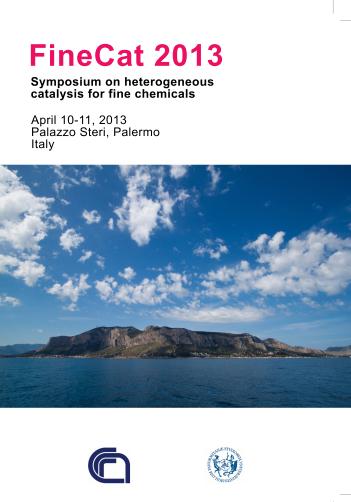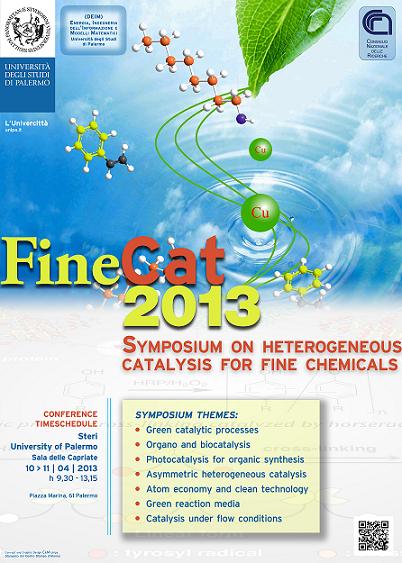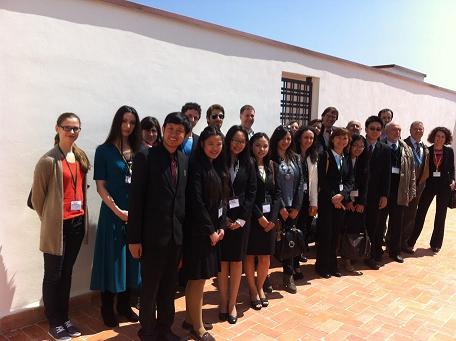| qualitas1998.net
|
FineCat 2013: Another Fine Catalysis Meeting in Sicily
An ISBN-indexed Book of Abstracts (available as eBook, 978-886-369-965-4) of accepted contributions was produced and handed out at the conference.
Photo gallery
«Ubi iacet dimidium, iacet pectus meum», concluded his Opening Address, University of Palermo’s Professor Pasquale Agozzino, husband of Professor Donato.
The scientific program featured 8 symposia and 13 poster presentation that highlighted exciting chemical innovation in fields as diverse as biomass conversion, flow chemistry, catalysis with metal nanoparticles, heterogeneous photocatalysis and doped hybrid silicas. Delegates from Kazakstan, the US, Israel, Thailand, Italy, Kuwait, Qatar and Germany pointed once again to the truly international nature of this Symposium series inaugurated in 2012.
Eminent chemists Claudio Bianchini, D. Tyler McQuade and Elio Santacesaria, gave the FineCat 2013 plenary lectures.
A Flow chemistry approach to catalysis
On April 10th, Florida State University and Max Planck Gesellschaft Professor Tyler McQuade opened the conference with a lecture on flow chemistry approach to catalysis.He explained that flow chemistry using heterogeneous catalysis has now reached a level where massive production of drugs at low cost has become possible. He showed, for example, how 1500 flow reactors could rapidly and economically afford artemisinin from dihydroartemisinic acid, meeting the world’s demand of this powerful antimalaria drug.
Traditional microreactor technology, he further added, is not suited to employ traditional solid catalysts, requiring instead the use of microcapsules and other wisely developed morphologies tailored for this powerful synthetic technique [Acc. Chem. Res. 46 (2013) 327-338]. He concluded his presentation showing the remarkable results obtained in flow with three solid catalysts (proline, copper- and zinc-based materials).
Synthetic photocatalysis, valorization of bioethanol and biodiesel
 The same day University of
Regensburg’s Maria
Cherevatskaya, a PhD student in the Prof. König’s Group,
explained how a number of different heterogeneous photocatalysis
are available to efficiently synthesize fine chemicals. The
right choice will depend on the bandgap, and on the light
wavelenght, but also on the light intensity which matters more
than originally expected [Angew. Chem. Int. Ed. 51 (2012) 4062].
The same day University of
Regensburg’s Maria
Cherevatskaya, a PhD student in the Prof. König’s Group,
explained how a number of different heterogeneous photocatalysis
are available to efficiently synthesize fine chemicals. The
right choice will depend on the bandgap, and on the light
wavelenght, but also on the light intensity which matters more
than originally expected [Angew. Chem. Int. Ed. 51 (2012) 4062].Cristina Della Pina (University of Milan) showed the creative approach by which efficient silicalite [ChemCatChem 2 (2010) 1587-1593] and, even better, gold-modified silicalite can selectively convert bioethanol into useful chemicals.
The first Symposium day was concluded by Professor Siriporn Jongpatiwut (Center of Excellence on Petrochemical and Materials Technology, Thailand): who showed a number of suitable catalysts and relatively mild processes for the conversion of vegetable oils into hydrogenated biodiesel and renewable jet fuel.
At the end of the 1st day, the University of Palermo’s Rectorate offered to the delegates a guided tour of the splendid Palazzo Steri, a medieval building located downtown in Palermo.
Electrochemical valorization of alcohols, heterogeneous hydrosylilation and aerobic oxidation of organotin compounds
The subsequent day, Claudio Bianchini, now a highly sought-after consultant and former director of an Italy’s CNR Institute, gave a remarkable talk on the latest developments using platinum and palladium as highly efficient nanocatalysts for the electrochemical valorization of alcohols.He showed how is Group based in Florence has developed a number of reproducible synthetic strategies to prepare catalysts suitable for the catalytic oxidation of low cost alcohols including ethanol and glycerol in fuel cells, affording at the same time valued chemicals and sustained release of electricity [ChemSusChem 3 (2010) 851-855].
Emphasizing that even Pt complexes can in certain cases be employed as molecular catalysts, he concluded that these materials are now mature for making bioalcohols fuel cells a commercial reality in specific market applications.
Research chemist Rosaria Ciriminna of Palermo’CNR showed the latest results using the sol-gel entrapped platinum catalyst SiliaCat Pt(0) in the hydrosilylation of alkenes. She emphasized that this closes the organosilicon synthetic cycle, as the catalyst is actually obtained using the product of one such reactions [ACS Sustain. Chem. Engineer. 1 (2013) 249-253].
Dr Alexander Khenkin (Weizmann Institute of Science, Israel) presented the remarkable results concerning the selective oxidation of organotin compounds catalyzed by polyoxometalate the H5PV2Mo10O40. The reaction mechanism has been demonstrated, and the process is currently being evaluated for scale up.
Valorization of bioglycerol
 The former head of University of Naples’
industrial chemistry course, Prof. Elio
Santacesaria concluded the Symposium oral presentation
sessions with a detailed lecture on glycerol as raw material in
the production of chlorohydrins and ter-butylethers (GBTE).
The former head of University of Naples’
industrial chemistry course, Prof. Elio
Santacesaria concluded the Symposium oral presentation
sessions with a detailed lecture on glycerol as raw material in
the production of chlorohydrins and ter-butylethers (GBTE).He first showed how the catalytic process developed by his Group, using biodiesel as extracting agent, efficiently affords GBTE in high yields directly mixed with biodiesel, greatly improving the properties of the resulting fuel mixture [Ener. Fuels, 24 (2010) 4668-4672].
He continued his lecture showing evidence of the reaction mechanism by which glycerol is selectively converted into mono and 1,2-dichlorohydrin by reaction with gaseous hydrochloric acid in the presence of catalytic amount of carboxylic acids [Ind. Eng. Chem. Res. 49 (2010) 964-970].
Not only epichlorohydrin can be isolated in almost quantitative yield but, using different carboxylic acid, also the monochlorohydrin can be isolated in high yields. The latter product is a direct precursor of glycidol, namely a valued fine chemical currently obtained by epoxidation of allyl alcohol.
Poster Presentation and Award
The poster prize was
awarded to Chulalongkorn University’s student Natcha Wongpraphairoat for her
presentation concerning the effects of the support in the
catalytic conversion of glycerol to propylene glycol over
supported copper/ZnO catalysts. A number of interesting poster were presented at the poster session on the Symposium 2nd day. Professor Halema Al-Kandari (Kuwait University): depicted the excellent results by which structurally tailored (by alkali metal doping) molybdenum oxide can be used to convert linear alkanes or methylcyclohexane into valued compounds.
University of Palermo’s Marianna Bellardita showed the first results of the photocatalytic synthesis of the aldehyde piperonal in water mediated by a TiO2 suspension.
Tommaso Tabanelli, a PhD student at the University of Bologna, illustrated a new mechanism for the gas-phase methylation of phenol. University of Messina’s PhD student Agata Fatima Lombardo described the synthesis of amides on different oxide catalysts.
Warapun Nakaranuwattana, an undergraduate student at Chulalongkorn University, Thailand, reported on the effect of Au loading on the catalytic performance of supported gold catalysts in the steam reforming of methanol.
Dr Damir Abdukhalykov (Institute of Organic Catalysis and Electrochemistry, Kazakhstan), described how W and Mo heteropolycompounds can be efficiently used to catalytically convert alkanes of natural gas in several valuable compounds (olefins, oxygen-containing compounds, syngas).
Putthida Arunjak (Chulalongkorn University, Thailand) presented the results of the aromatization of n-pentane over a modified HZSM-5 zeolite. Students Nichapat Niyomthong and Warayut Ubolcharoen from the same University reported, respectively, the effect of silica:alumina ratio in the direct methylation of benzene by methane using indium-doped ZSM-5 zeolite, and the direct conversion of glycerol to aromatic hydrocarbons over modified HZSM-5.
University of Palermo’s Piera Demma Carà presented the results obtained in the heterogeneous conversion of furfuryl alcohol into butyl levulinate using mesoporous silicas functionalized with sulfonic acid.
Finally, Weerayut Dulyalaksananon and Chanon Kritsanakun, both students at Chulalongkorn University, Thailand, respectively described the results of ethylene epoxidation in a parallel plate barrier discharge system, and the hydrocracking of hydrogenated biodiesel over Pt/HY catalysts for producing hydrotreated renewable jet fuel.
Towards FineCat 2014
In summary the FineCat yearly meeting series opened with FineCat
2012 [PDF], is emerging as a not-to-miss event in
one of the main field of contemporary chemical research, namely
heterogeneous molecular and metal catalysis for fine chemicals
synthesis.Fine chemicals -- polyfunctional molecules with specific properties imparting them high added value -- have traditionally been synthesized via selective homogeneous synthetic methods. All this is now changing as newly developed heterogeneous catalysis emerges as a convenient industrial tool in making the fine chemicals industry not only environmentally , but also economically, more sustainable.
In the meanwhile, too, biomass feedstock is emerging to replace raw materials of petrochemical origin; thereby closing the materials cycle that makes chemical processes truly sustainable.
Research presented at FineCat 2013 has hopefully further advanced this progress, by disseminating new knowledge and promoting scientific exchange and networking in the typical informal style of the Symposium further eased by the unique milieu of the 1,000 years old Palazzo Steri.
On the afternoon of April 11th, a bus reached the Tenuta Regaleali Estate namely the heart of the Tasca d'Almerita family’s wine production wherein, following a guided tour of the winemakery, a Sicilian dinner was offered to registered delegates in a wonderful estate dating back to the 18th century.
The 3rd edition of the FineCat Symposium will be held in Sicily on April 9-10, 2014.
Photogallery
A nice photo- and videogallery has been made available to the Symposium delegates.Acknowledgements
Thanks to the Rector of Palermo’s University, Prof. Roberto Lagalla, for hosting us in this magnificent conference venue.The organization of FineCat Symposium series, including of course the 2013 edition, would not have been possible without the advice and assistance of Marzia Sciortino and Giovanni Palmisano. We wish to express our sincere appreciation to each of them also for the energy, good will and enthusiasm put in the organization of the Symposium.
We are indebted with Medielettra for kindly providing the poster support systems suitable for the delicate environment of Palazzo Steri.
Our thanks go also to Mr Lorenzo Giuggiolini of Simplicissimus Book Farm for his usually excellent editorial support in producing the Book of Abstract. Similarly, we thank Dr Maria Izzo for the wonderful picture reproduced on the cover of the volume.
Further information
Dr R. Ciriminna (rosaria.ciriminna@cnr.it) - Prof. L. Palmisano (leonardo.palmisano@unipa.it)Back to the FineCat Home-Page
